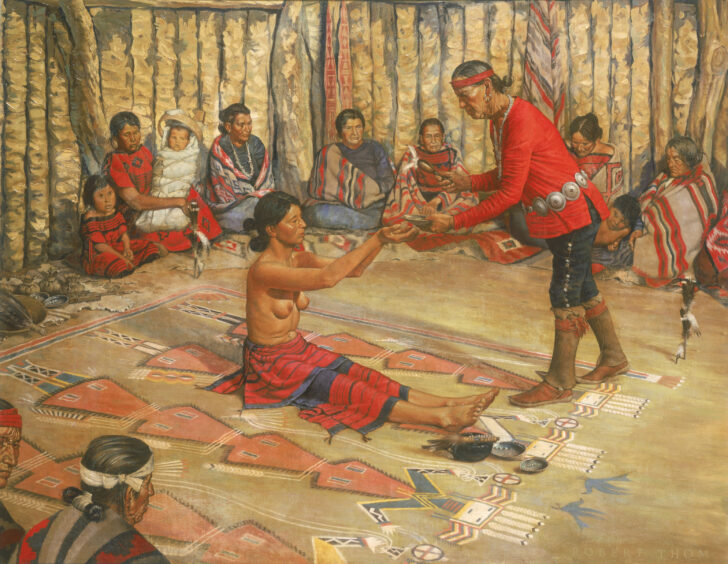Native Healing, from “The History of Medicine”
Robert Thom

Description
“Primitive Medicine,” later retitled “Native Healing,” is one of the first illustrations amid the thematic collection Great Moments in Medicine, commissioned by Parke, Davis & Company in 1948. The author-illustrator duo, George A. Bender and visual artist Robert A. Thom went to great lengths to attest to the accuracy and “authenticity” of their illustrations and accompanying historical texts, scrupulously documenting the 13 months and 15,000 miles of travel necessary for the completion of this work alone. (Today’s Health, 58). Bender and Thom traveled to Santa Fe and Gallup, New Mexico on two occasions to learn about the practice of Navajo sandpainting and to study the imagery of Navajo “long bodies” as documented by anthropologist Washington Matthews in the late nineteenth century (Duro, 100). The duo hired Billy Norton, a Navajo medicine man (hataali), to pose for their photograph preparations and perform a traditional healing ceremony. As art historian Paul Duro notes, “It is laudatory that Navajo healing was included in this endeavor [Great Moments in History], but regrettable that it was located in antiquity; the ritual they watched circa 1957 was and remains a living part of Navajo culture today” (Duro, 101). Much like Thom’s illustration, Bender’s historical text stubbornly relegated an active and living healing practice to a “timeless” past. His original caption read:
Primitive medicine is timeless. It is as old as the cave dweller, yet in many remote parts of world its practice is as new as today. The sandpainting ceremonies of American Navaho Indians are unusually beautiful examples of primitive medicine, embodying all its elements --physio--and psychotherapy, religion, magic, singing, and drug lore. In a medicine "hogan" family and friends join in the Mountain Chants' nine-day ceremonies, in which this sandpainting has an important part. The "singer" (medicine man) sings, prays, and manipulates magico-religious artifacts. Herb preparations given the patient are shared by the "singer" and by the spectactors too in this primitive health-seeking rite.
The illustration, text, and title characterized Native healing practice as “primitive” and “timeless” and therefore static and stuck in the past. Despite over a year’s worth of research, Thom and Bender failed to acknowledge the ongoing, operative nature of a Navajo healing practice.
Considering the reductive nature of this image and text pairing, Primitive Medicine may be hard to view. Despite Thom and Bender’s limited and nostalgic representation of Navajo life, how may we use this work to reflect on both our past and present and our ongoing evolution of cultural understanding?
Usage Rights:
If you are interested in using an image for a publication, please visit https://umma.umich.edu/request-image/ for more information and to fill out the online Image Rights and Reproductions Request Form.